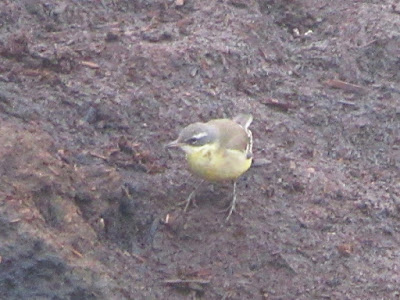 |
| Eastern Yellow Wagtail at Sedgeford |
 |
| considered of the race tschutschensis breeding from Siberia to Alaska and wintering in the Phillipines, Indonesia, South East Asia and now Norfolk |
 |
| on the dung heap it looked long legged |
 |
| its patchy underparts were quite bright yellow in places |
 |
| skeins of Pink-feet over Sedgeford |
Thursday 02 January. After some discussion we decided to spend the day in the Brecks, returning to Lyndford Arboretum where we saw a Crossbill in flight, 9 Hawfinches and 4 Marsh Tits. Santon Downham produced 3 more Hawfinches, Kingfisher, Water Rail,Treecreeper and a superb Otter. The otter was probably a young one and appeared to be eating a Moorhen. It was the first I'd seen away from Shetland. We went to Livermere seeing a handful of Tree Sparrows, mostly in flight, in scrub by the church and 4 Canada Geese on the lake, about one of the least memorable birds to see as my 100th species. Driving back north to Lakenheath we saw 6 Red-legged Partridges by the road but couldn't pick anything out amongst the gulls around the pig farms although most were quite distant. I'd not been to Lakenheath since there were Golden Orioles there and didn't recognise anything. DB picked out a Yellow-legged Gull amongst 1200 Lesser Black-backs on the main lagoon. They were not too far away but I was reminded of how I'm not keen on gulls on reservoirs, it is hard to get a feel of their structure and one has no chance of reading any colour-rings. We walked out towards the main reedbed flushing 2-3 Water Pipits and a Great White Egret but failing to even hear Bearded Tit. From a lookout we watched the Marsh Harriers coming in, seeing at least 19, and right at the death, 20 minutes after sunset, a flock of six Cranes flew in calling. We'd hoped they'd fly around and drop into the reedbed but they continued. It was an excellent finish to what until then had been a little disappointing day. Lakenheath was a superb reserve but with reedbeds, particularly in winter, one is heavily reliant on secretive birds like Bitterns appearing for you. Walking back in the dark the passing warden gave us a lift in this 4WD and told us the reserve had been created for the cost of a detached house in Cambridge. Unfortunately we didn't have a spare house (detachedor otherwise) to enable him to increase its size.
 |
| Otter at Santon Downham |
 |
| it didn't seem too concerned by our presence on the opposite side of the river |
 |
| viewpoint at Lakenheath |
 |
| sunset |










No comments:
Post a Comment
Note: only a member of this blog may post a comment.